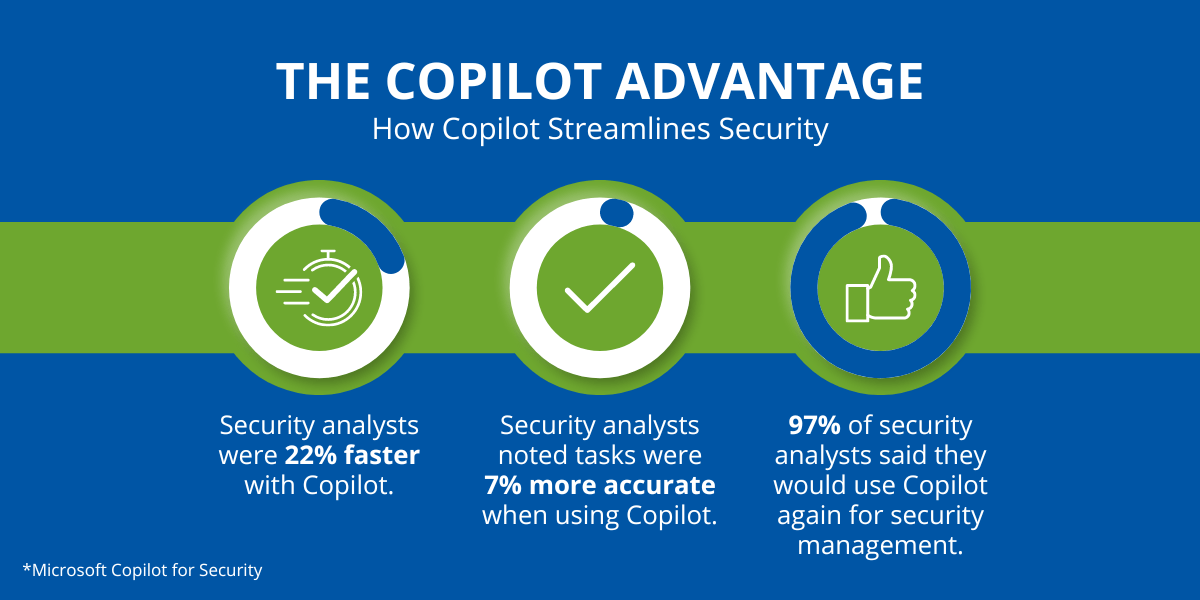AI is revolutionizing co-managed IT and Microsoft Copilot for Security is a natural to join the fight. It enhances efficiency, strengthens security, and empowers IT teams. Copilot frees you from repetitive tasks, letting you focus on what matters most — your business.
Despite its clear advantages though, misconceptions still linger about Microsoft Copilot’s role within an IT infrastructure. In this blog, we’ll bust 5 common myths surrounding the marriage between Microsoft’s Copilot for Security and co-management. Then, we’ll outline how the team at CorCystems can utilize Copilot AI responsibly to propel your co-managed IT services to the next level.
Ready to take the leap?
Myth 1: “Copilot AI Will Replace IT Staff”
Reality:
The fear that AI will replace IT staff is a common concern, but it overlooks the fact that Copilot for Security is meant to empower teams, not eliminate them. Overall, Copilot helps IT security professionals by automating tedious tasks and providing intelligent assistance.
Practical Example:
One such repetitive task is Incident Summarization. Typically, analyzing an incident requires staff to gather data, identify the root cause, and report on their findings. Copilot AI handles this efficiently, compiling relevant information and generating comprehensive summaries. Freed from repetitive tasks by Copilot, your IT team can shift their focus to more high-impact initiatives.
Myth 2: “Copilot Compromises Security”
Reality:
While it’s natural to be wary of new technologies, integrating AI into IT operations does not inherently create security vulnerabilities. In fact, Copilot employs cutting-edge AI algorithms to detect anomalies and identify potential threats. At CorCystems, we leverage these algorithms to proactively protect clients by recognizing suspicious patterns and isolating risks before they escalate.
Proactive Threat Detection:
Copilot AI’s anomaly detection tools are vital in identifying emerging threats. Its guided response and reverse engineering scripts allow IT teams to swiftly analyze potential breaches, understand their impact, and deploy remediation tactics that protect sensitive data. Furthermore, CorCystems is committed to responsible AI usage policies. Our continuous system monitoring reinforces security protocols, safeguarding your business against malicious attacks.
Myth 3: “AI Doesn’t Understand Real-World IT Problems”
Reality:
It’s often believed that AI struggles to solve real-world IT challenges due to their complexity. This view overlooks how Microsoft Copilot’s extensive training data and machine learning models enable it to analyze issues from multiple perspectives. CorCystems configures Copilot to provide precise incident summaries, impact analysis, and tailored solutions that align with your IT environment’s unique requirements.
Incident Summarization and Impact Analysis:
Copilot’s capacity for incident summarization means it can sift through logs and alerts to deliver concise summaries. Its impact analysis capabilities help IT teams identify affected systems, understand the threat’s magnitude, and prioritize remediation tasks. With this level of insight, IT staff can address pressing issues swiftly and allocate resources more effectively.
Myth 4: “AI Lacks Transparency in Operations”
Reality:
Transparency is a cornerstone of effective IT management, and Copilot prioritizes clarity through its guided response and reporting features. Each response provides a step-by-step explanation of the incident’s root cause and the recommended resolution path. CorCystems integrates these reports into your existing workflows to ensure that Copilot’s actions and decision-making process are fully transparent.
Guided Response:
The guided response feature equips IT staff with a clear, actionable plan for remediation. Reports include detailed information about threat vectors, affected systems, and remediation steps. This transparency builds trust between Copilot and the IT team, fostering collaboration and confidence in AI’s decision-making process.
Myth 5: “Copilot Is Hard to Integrate with Existing Systems”
Reality:
Another misconception is that Copilot’s integration necessitates a complete IT overhaul. However, the platform is designed for seamless incorporation into existing co-managed IT services. CorCystems helps businesses align Copilot AI with current processes by providing tailored guidance, so the integration enhances your IT infrastructure without disrupting operations.
Strategic Integration:
Copilot’s incident summarization, guided response, and anomaly detection capabilities are configured to complement your existing workflows. This minimizes disruptions and maximizes Copilot’s effectiveness, whether it’s detecting emerging threats or handling automated ticket resolution.
Unlock the Power of Co-Managed IT with Microsoft Copilot AI
Debunking these myths reveals how Microsoft Copilot AI, when responsibly handled by CorCystems, provides substantial benefits to co-managed IT services.
From empowering IT staff to streamlining security, Copilot AI is an invaluable asset that bolsters efficiency, proactively identifies threats, and complements your IT team through strategic automation.
Curious about how Copilot AI can transform your IT operations? Book a consultation with CorCystems to discover how strategic automation can help elevate your business today.







